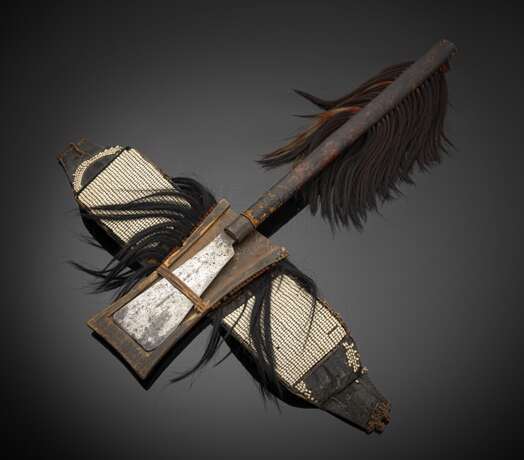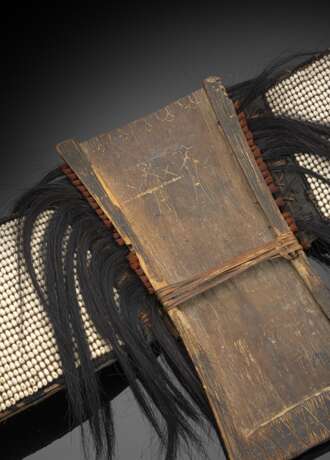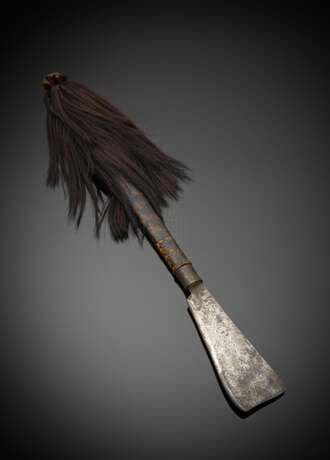ID 1218037
Lot 1520 | Haumesser / Beil ''dao'' der Naga-Ethnien, Konyak-Naga
Estimate value
€ 800 – 1 200
L. 76 cm
Das dao, ein traditionelles Messerbeil der Konyak-Naga. Es hat einen langen Schaft aus mittelschwerem Holz und eine einseitig geschliffene, vorn abgeflachte Klinge. Der Griff ist mit gefärbten Ziegenhaaren besetzt - früher Ausweis des erfolgreichen Kriegers und Kopfjägers. Das Blatt steckt in einer einseitig offenen hölzernen Scheide an einem breiten Ledergurt. Das Messer hat aufgrund des prächtigen Gürtels einem hochrangigen Besitzer gehört. Aufgrund der Ritzzeichnungen in der Hüftgürtelhalterung kann der Gürtel den Konyak-Naga-Gruppen zugeordnet werden. Für die Verzierung am breiten ledernen Hüftgürtel diente die Kaurischnecke, die dem Träger Ansehen und Wohlstand verleiht. Sie ist u.a. eine historische Form von Primitivgeld, die in Afrika, Ost- und Südasien und der Südsee als vormünzliches Zahlungsmittel weit verbreitet war, in Südasien endete die Verwendung jedoch im 19. Jahrhundert. Wegen der Ähnlichkeit mit dem weiblichen Geschlechtsteil wird der Kaurischnecke große Bedeutung als Fruchtbarkeitssymbol zugesprochen. In Japan und Indien wird die Kaurischnecke teilweise immer noch als Talisman von der Entbindenden in der Hand gehalten. Das dao ist ein vom Norden Assams bis in den Süden Burmas und Siams weit verbreitetes Allzweckwerkzeug, das von der Rasur und dem Haarschnitt bis zum Fällen von Bäumen und dem Verarbeiten von Holz aller Arten und Stärken verwendet wird. Oft ist es neben kleinen Messern das einzige verfügbare Werkzeug. Das dao wird an starken Rattan- oder Rindenfaser-Gurten im Rücken über dem Gesäß getragen; als Scheide dient ein kastenförmiges Holz- oder Rattanelement. Die Scheiden können geschlossen oder auf der vom Träger wegweisenden Seite offen sein. Das Volk der Konyak - auch bekannt als Konyak Naga - ist eine tibeto-burmesische ethnische Gruppe der Naga, die hauptsächlich im nordostindischen Bundesstaat Nagaland beheimatet ist. Die Konyak-Naga-Sprachen - auch Konyak-Sprachen oder Nord-Naga-Sprachen - bilden eine Untereinheit der Bodo-Konyak-Jingpho-Sprachen, die zu den tibeto-birmanischen Sprachen gehören, einem Primärzweig des Sino-Tibetischen. Die sieben Konyak-Naga-Sprachen werden von etwa 300.000 Menschen in Nordost-Indien in den Bundesstaaten Arunachal Pradesh und Nagaland gesprochen.
Aus einer alten deutschen Privatsammlung, seit den 1950er Jahren gesammelt - Minim. Alters- und Gebrauchsspuren, partiell fehlende Haarsträhnen und Perlen
| Auction house category: | Ethnographic tribal art |
|---|
| Auction house category: | Ethnographic tribal art |
|---|
| Address of auction |
Nagel Auktionen GmbH Neckarstrasse 189 - 191 70190 Stuttgart Germany | ||||||||||||||
|---|---|---|---|---|---|---|---|---|---|---|---|---|---|---|---|
| Preview | |||||||||||||||
| Phone | +49 (0)711 649 690 | ||||||||||||||
| Fax | +49 (0)711 649 69696 | ||||||||||||||
| Buyer Premium | 29,5% | ||||||||||||||
| Conditions of purchase | Conditions of purchase | ||||||||||||||
| Business hours | Business hours
|





